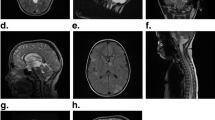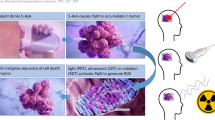Abstract
The aim of the present study was to evaluate the impact of first-line radiotherapy on low-grade gliomas (LGGs) growth kinetics. The mean tumor diameter (MTD) of 39 LGGs was retrospectively measured on serial magnetic resonance images before (n = 16) and after radiotherapy onset (n = 39). After radiotherapy, a decrease of the MTD was observed in 37 patients. Median duration of the MTD decrease was 1.9 years (range 0–8.1 years). According to RANO criteria, the rates of partial and minor responses were 15 and 28 % at the first evaluation after radiotherapy and 36 and 34 % at the time of maximal MTD decrease. The presence of a 1p19q codeletion and the absence of p53 expression were associated with longer durations of MTD decrease (5.3 vs 1 years, p = 0.02 and 2.4 vs 1.8 years, p = 0.05, respectively) while no association was observed between IDH1-R132H expression and duration of MTD decrease. In most patients, MTD decrease after radiotherapy occurred in two phases: an initial phase of rapid MTD decrease followed by a second phase of slower MTD decrease. Patients with a high rate of MTD decrease during the initial phase (>7 mm/year) had both a shorter duration of response (1.9 vs 5.3 years, p = 0.003) and a shorter overall survival (5.5 vs 11.6 years, p = 0.0004). LGGs commonly display a prolonged and ongoing volume decrease after radiotherapy. However, patients who respond rapidly should be carefully monitored because they are at a higher risk of rapid progression.




Similar content being viewed by others
References
Mandonnet E, Delattre JY, Tanguy ML et al (2003) Continuous growth of mean tumor diameter in a subset of grade II gliomas. Ann Neurol 53:524–528
Ricard D, Idbaih A, Ducray F et al (2012) Primary brain tumours in adults. Lancet 379:1984–1996
Peyre M, Cartalat-Carel S, Meyronet D et al (2010) Prolonged response without prolonged chemotherapy: a lesson from PCV chemotherapy in low-grade gliomas. Neuro Oncol 12:1078–1082
Ricard D, Kaloshi G, Amiel-Benouaich A et al (2007) Dynamic history of low-grade gliomas before and after temozolomide treatment. Ann Neurol 61:484–490
Soffietti R, Baumert BG, Bello L et al (2010) Guidelines on management of low-grade gliomas: report of an EFNS-EANO Task Force. Eur J Neurol 17:1124–1133
van den Bent MJ, Wefel JS, Schiff D et al (2011) Response assessment in neuro-oncology (a report of the RANO group): assessment of outcome in trials of diffuse low-grade gliomas. Lancet Oncol 12:583–593
Desestret V, Ciccarino P, Ducray F et al (2011) Prognostic stratification of gliomatosis cerebri by IDH1 R132H and INA expression. J Neurooncol 105:219–224
Kaloshi G, Benouaich-Amiel A, Diakite F et al (2007) Temozolomide for low-grade gliomas: predictive impact of 1p/19q loss on response and outcome. Neurology 68:1831–1836
Bauman G, Pahapill P, Macdonald D et al (1999) Low grade glioma: a measuring radiographic response to radiotherapy. Can J Neurol Sci 26:18–22
Eyre HJ, Crowley JJ, Townsend JJ et al (1993) A randomized trial of radiotherapy versus radiotherapy plus CCNU for incompletely resected low-grade gliomas: a Southwest Oncology Group study. J Neurosurg 78:909–914
Lunsford LD, Somaza S, Kondziolka D et al (1995) Survival after stereotactic biopsy and irradiation of cerebral nonanaplastic, nonpilocytic astrocytoma. J Neurosurg 82:523–529
Pallud J, Llitjos JF, Dhermain F et al (2012) Dynamic imaging response following radiation therapy predicts long-term outcomes for diffuse low-grade gliomas. Neuro Oncol 14:496–505
Ribba B, Kaloshi G, Peyre M et al (2012) A tumor growth inhibition model for low-grade glioma treated with chemotherapy or radiotherapy. Clin Cancer Res 18:5071–5080
Cairncross G, Berkey B, Shaw E et al (2006) Phase III trial of chemotherapy plus radiotherapy compared with radiotherapy alone for pure and mixed anaplastic oligodendroglioma: Intergroup Radiation Therapy Oncology Group Trial 9402. J Clin Oncol 24:2707–2714
van den Bent MJ, Carpentier AF, Brandes AA et al (2006) Adjuvant procarbazine, lomustine, and vincristine improves progression-free survival but not overall survival in newly diagnosed anaplastic oligodendrogliomas and oligoastrocytomas: a randomized European Organisation for Research and Treatment of Cancer phase III trial. J Clin Oncol 24:2715–2722
Acknowledgments
The authors wish to acknowledge Johan Pallud for valuable discussions and Marie Aline Renard for her valuable help collecting data.
Conflict of interest
None.
Author information
Authors and Affiliations
Corresponding author
Electronic supplementary material
Below is the link to the electronic supplementary material.
11060_2013_1224_MOESM1_ESM.tif
Supplementary material 1 (TIFF 108 kb). Observed MTD values versus individual predicted MTD values using mathematical modeling. The MTD decrease after radiotherapy was modeled using the Monolix software (Lixoft) based on the hypothesis that treatment response consisted of a single phase of linear decrease (y = ax +b) or of two distinct phases of linear decrease (y = a1x + b followed by y = a2x + c). As shown, the model based on the two phase hypothesis (right) was much more accurate than the model based on the single phase hypothesis (left)
Rights and permissions
About this article
Cite this article
Ducray, F., Kaloshi, G., Houillier, C. et al. Ongoing and prolonged response in adult low-grade gliomas treated with radiotherapy. J Neurooncol 115, 261–265 (2013). https://doi.org/10.1007/s11060-013-1224-1
Received:
Accepted:
Published:
Issue Date:
DOI: https://doi.org/10.1007/s11060-013-1224-1




